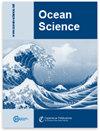热带西部边界流系统中浮游刺胞生物对热盐和环流季节情景的响应
IF 4.1
3区 地球科学
Q2 METEOROLOGY & ATMOSPHERIC SCIENCES
引用次数: 1
摘要
摘要在西部边界流系统(WBCSs)中,强流带着海洋水团及其相关的浮游动物群向海岸流动。这些洋流和大陆径流强度的变化可能会影响海洋和沿海群落之间的动态相互作用。此外,大陆径流和热盐结构的变化调节了初级生产,增加了这些少营养系统动力学的复杂性。这些动态可能塑造了浮游刺胞动物群落。为了进一步了解这种关系,我们使用了一个综合数据集,其中包括在热带南大西洋西部的Fernando deNoronha Ridge的大陆架和斜坡上以及海洋海山和岛屿周围收集的样本,这些样本在两个季节中以不同的温盐结构和环流模式为特征。结果表明,在热带南大西洋和其他可能具有狭窄大陆架的西部边界系统中,沿海洋流将海水及其相关的刺胞动物物种传播到大陆架上。然而,虽然沿海和海洋群落在大陆径流显著时共同出现,但在以更强的边界流强度为特征的旱季,海洋物种几乎主导了整个大陆架。当混合层深度和相关的营养线较浅时,通过自下而上的控制,初级生产力的提高支持浮游刺胞动物的大种群。本文章由计算机程序翻译,如有差异,请以英文原文为准。
Planktonic cnidarian responses to contrasting thermohaline and circulation seasonal scenarios in a tropical western boundary current system
Abstract. In western boundary current systems (WBCSs), strong
currents flow coastward carrying oceanic water masses and their associated
planktonic fauna. Variation in the intensity of these currents and in the
continental runoff may affect the dynamic interplay between oceanic and
coastal communities. In addition, changes in the continental runoff and the
thermohaline structure modulate the primary production, adding complexity to
the dynamics of these oligotrophic systems. These dynamics likely shape the
planktonic cnidarian communities. To further understand such relationships,
we used a comprehensive dataset encompassing samples collected above the
shelf and slope and around oceanic seamounts and islands of the Fernando de
Noronha Ridge in the western tropical South Atlantic, in two seasons
characterised by distinct thermohaline structure and circulation patterns.
Results show that in the tropical South Atlantic and, likely, other western
boundary systems with narrow continental shelves, coastward currents spread
oceanic waters and their associated cnidarian species over the continental
shelf. However, while both coastal and oceanic communities co-occur when the
continental runoff is notable, oceanic species dominate almost the entire
shelf during the dry season characterised by a stronger boundary current
intensity. We also conclude that when the mixed-layer depth and associated
nutricline are shallower, the enhanced primary productivity supports larger
populations of planktonic cnidarian species through a bottom–up control.
求助全文
通过发布文献求助,成功后即可免费获取论文全文。
去求助
来源期刊

Ocean Science
地学-海洋学
CiteScore
5.90
自引率
6.20%
发文量
78
审稿时长
6-12 weeks
期刊介绍:
Ocean Science (OS) is a not-for-profit international open-access scientific journal dedicated to the publication and discussion of research articles, short communications, and review papers on all aspects of ocean science: experimental, theoretical, and laboratory. The primary objective is to publish a very high-quality scientific journal with free Internet-based access for researchers and other interested people throughout the world.
Electronic submission of articles is used to keep publication costs to a minimum. The costs will be covered by a moderate per-page charge paid by the authors. The peer-review process also makes use of the Internet. It includes an 8-week online discussion period with the original submitted manuscript and all comments. If accepted, the final revised paper will be published online.
Ocean Science covers the following fields: ocean physics (i.e. ocean structure, circulation, tides, and internal waves); ocean chemistry; biological oceanography; air–sea interactions; ocean models – physical, chemical, biological, and biochemical; coastal and shelf edge processes; paleooceanography.
 求助内容:
求助内容: 应助结果提醒方式:
应助结果提醒方式:


